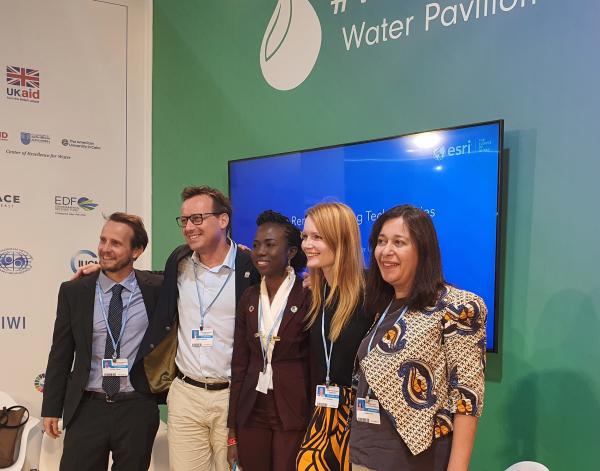Water and adaptation to climate change: the role of systems thinking
12 Nov 2022 by The Water Diplomat

On the 12th of November at COP 27, the Alliance for Global Water Adaptation, the Water and Climate Coalition, UNEP and the UNFCCC partnered to present an event on systems thinking for the integration of water into National Adaptation Plans (NAPs) and Nationally Determined Contributions (NDCs).
Maria Kosonen, speaking on behalf of the Water and Climate Coalition stated that in the context of the current water crisis and with water at the centre of all SDGs, we need systems thinking to resolve issues, and because most of the effects of climate change are felt through water, we need to approach adaptation through the lens of water. Systems thinking can take our thinking in new directions: for instance, the fashion industry has a very large water footprint: one kg of cotton has a water footprint of 20 000 litres. Therefore, improving water efficiency in agriculture can make cotton production more sustainable.
Bhava Dhugana, speaking on behalf of UNFCCC, pointed out that under the Enhanced Transparency Framework in the Paris Agreement, countries are requested to submit Nationally Determined Contributions to climate migation and adaptation (NDC’s). Every two years, there is a review of the transparency framework during which progress on implementation is tracked in order to monitor compliance with the Paris Agreement.In addition, every five years there is a global stocktake on progress. The Consultative Group of Experts review incoming NDC reports. Within the sub-theme of adaptation, there are three focal areas: technical backstopping, technical infrastructure and practical guidance. Within the section on adaptation, both water and agriculture feature very prominently. One challenge going forward is capacity building: the UNFCCC has a adaptation academy which provides a three week in depth training programme in partnership with AGWA, IHE Delft, Oregon State University and others.
Jessica Troni, speaking for UNEP, pointed out that systems thinking assumes that various factors are interlinked, therefore affecting one element has an impact on other elements: clearing land for agriculture for instance has an impact on water infiltration into the ground and replenishment of groundwater. Similarly, trees, through evapotranspiration, generate atmospheric water that can be transported up to a distance of 500 km away and supplement rainfall far from the forests themselves. Higher temperatures lead to more atmospheric moisture and therefore heavier precipitation events.All these elements can be brought together at a systems level, for which Integrated Water Resources Management (IWRM) is a generally accepted tool. This requires an integrated planning approach between local government levels, local stakeholders and the river basin level, as well as tools and data for planning and adequate financing. This systems approach requires access to different kinds of information, certainly in the context of climate change: the various impacts of climate change on the water cycle need to be incorporated into river basin planning. IWRM in itself is therefore an adaptation strategy, and therefore IWRM needs to be included in national adaptation plans and therefore integrated into NDC’s.
Finally, Prof Moshood Tijani shared a perspective from the African Ministerial Council on Water (AMCOW). The African Ministerial Council on Water was created in 2002 for a coordinated management of the shared waters of the African continent. Water security challenges in Africa are a matter for concern due to, amongst others, increasing population growth, rapid growth of cities, and rising living standards and a resultant increase in water demand. Groundwater is a focal point for adaptation because it enhances water security despite fluctuations in precipitation: enhancing the emphasis on sustainable groundwater management is therefore a part of the overall climate adaptation strategy across Africa. If we are to ensure sustainable groundwater management, the overall water resources assessment is very important, as is appropriate technology to sustainably extract water, clear transboundary agreements on shared waters, as well as capacity building to integrate all these factors.
